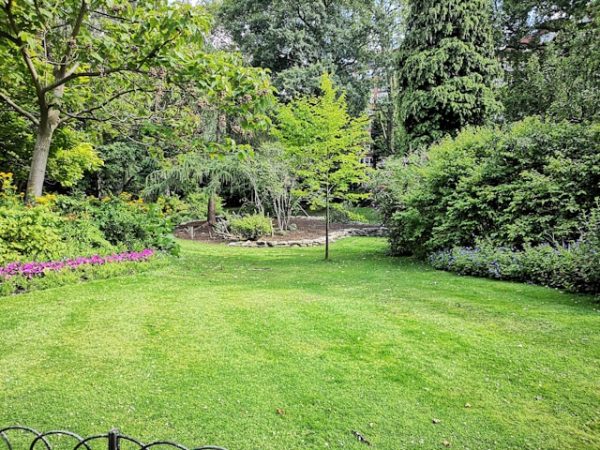There are some things that can be really hard to balance. So, if you consume any content about gardening and lawns, you’re going to find plenty of tips on how to create aesthetic lawns, but you’re also going to find a lot of content about why sustainability needs to be prioritized more.
But the right is, how do you keep that gorgeous green space both eco-friendly and free of pesky intruders? It might seem like an impossible dream, but honestly, it does sound fairly far-fetched. But it can definitely be possible (granted maybe a tad challenging). So, here’s everything you need to know about creating a delightful dance of creating a lush, environmentally friendly, and pest-free lawn.
You Need to Understand Your Lawn’s Ecosystem
First things first, let’s talk about your lawn as an ecosystem. Yes, that patch of green outside your window is more than just grass. It’s a living, breathing community. This truly does go beyond aesthetics. Just think about it for a moment: healthy soil, diverse plant life, and beneficial insects all play a part in this mini-ecosystem. So that’s exactly why understanding this is key to maintaining an eco-friendly lawn with local sunshine coast pest control that also keeps pests at bay.
When you treat your lawn as an ecosystem, you begin to see that every part is interconnected. Plus, beneficial insects, like ladybugs and bees, help control pests and pollinate plants. But overall, healthy soil supports strong grass growth, which naturally reduces the space and nutrients available for weeds. As you see, there’s a lot that goes into it, and that green patch of grass does far more than make your property look pristine.
Choose the Right Grass and Plants
Now, you have to understand that selecting the right grass and plants for your lawn is the foundation of both eco-friendliness and pest control. Native grasses and plants are your best friends here. They’re adapted to your local climate, require less water, and are naturally resistant to local pests. Plus, they provide habitat for local wildlife, which adds to the overall health of your lawn ecosystem.
You might also want to consider mixing different types of grasses and plants to create diversity. This not only makes your lawn more resilient but also more resistant to pests. Just think of it this way; a diverse lawn is like a strong community; it can withstand challenges better than a monoculture.
Water Wisely, Not Wastefully
So this one is pretty obvious, but it still deserves a lot of attention. So, you have to understand that watering your lawn effectively is a crucial part of eco-friendly lawn care. Overwatering can lead to runoff, which wastes water and can carry harmful chemicals into the local water supply. Plus, it creates a perfect breeding ground for pests like mosquitoes. You think you’re doing something good, but in more ways than one, this can be really bad.
So, overall, the key is to water deeply but infrequently. This encourages the grass to develop deep roots, making it more drought-resistant and less attractive to pests. Ideally, you’ll want tow after right earlier in the morning because early morning is the best time to water, as it reduces evaporation and gives the lawn time to dry out before nightfall, preventing fungal growth.
Organic Mulch is a Double-Edged Sword
Hands-down mulching is a fantastic eco-friendly practice that conserves moisture, improves soil health, and suppresses weeds. However, there’s a catch: mulch can also attract pests. That’s right, you can expect termites, earwigs, and certain beetles to love organic mulch as it provides food and a perfect hiding spot.
So, it’s going to be best to look into keeping the mulch from becoming a pest hotel, so you’ll need to apply it sparingly and avoid piling it directly against plant stems or tree trunks. And remember to periodically turn and refresh the mulch to disrupt any pest colonies that might be setting up camp.
Composting Can Be Challenging
Basically, this is your lawn’s best friend, but at the same time, this is a major pest magnet. Needless to say, composting is an excellent way to enrich your soil naturally. But here’s the thing: improperly managed compost can attract pests like rodents, raccoons, and flies. Even if you have a pile of leaves during autumn, this too can attract pests such as snakes, rodents, and bugs. So how can you avoid this?
Well, there are different ways to go about this. For example, you can use an electric blower to remove all the leaves during the autumn months (make sure to take care of these ASAP). But when it comes to your actual compost bin, you’ll also need to make sure that this is balanced out, so you’re going to want to go with both green (nitrogen-rich) and brown (carbon-rich) materials and turn it regularly to maintain high temperatures that deter pests.
A proper compost bin will have a knob where you can spin at. Plus, using a closed compost bin can also help keep unwanted visitors out.
Look into Natural Weed Control
Weeds are the bane of every lawn enthusiast’s existence, but reaching for chemical weed killers isn’t the answer if you’re aiming for eco-friendliness. Instead, try natural methods. Mulching, as mentioned, is one method, but it’s essential to be aware of the pest issue.
Here’s an example: corn gluten meal is a natural pre-emergent herbicide that can prevent weed seeds from germinating without harming your grass. However, it can also attract rodents. Honestly, it’s all really hard to balance, but to minimize this risk, apply corn gluten meal sparingly and only in areas where it is needed most.
Embrace Natural Pest Control Methods (Carefully)
Here’s where things get really interesting. Nature has its own pest control methods, and they’re way more sustainable than chemical alternatives. But overall, encouraging beneficial insects and predators can help keep pest populations in check.
However, attracting these helpful critters can sometimes invite less desirable guests. For example, bird feeders can bring in birds that help with pest control but might also attract squirrels and other rodents. Bat boxes can encourage bats that eat mosquitoes, but they might also become a home for wasps if not maintained properly. The key is to regularly monitor and manage these natural pest control methods to ensure they are benefiting your lawn without introducing new problems.


